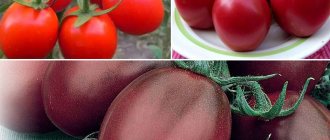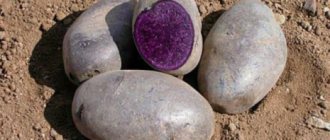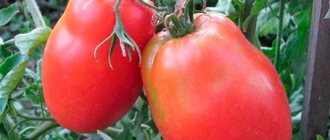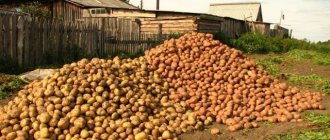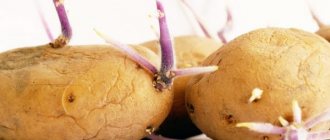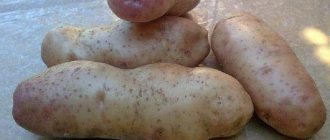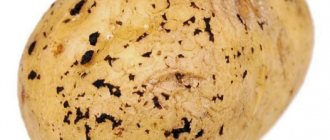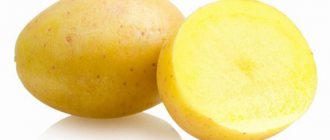It is worth starting the description of the Innovator potato variety with its characteristics. The variety was bred by Dutch breeders. The taste qualities and versatility of potato preparation allowed the variety to enter the top ten world varieties of crops.
Innovator potatoes appeared on the Russian market more than 20 years ago, but were included in the state register only in 2010. In Russia, the variety is popular due to its developed resistance to unstable weather conditions.
Characteristics of potatoes Innovator
The Innovator potato variety is used for industrial processing. The root vegetable is distinguished by its versatility in preparation: it is used for preparing salads, French fries, as well as for frying, stewing and baking in foil. Based on taste characteristics, root vegetables are rated 4 points. In terms of ripening time, the Innovator variety is classified as mid-early, since potatoes can be dug up within 65-80 days after planting.
Like the Drova variety, Innovator is distinguished by its high yield: one bush produces up to 15 potatoes.
In addition, potatoes are distinguished by high shelf life, resistance to transportability and excellent presentation. It should also be noted that Innovator potatoes are drought-resistant and are excellent for growing in steppe regions.
- Characteristics of plant bushes: potato bushes reach medium sizes (rarely tall) and are of the erect, slightly spreading type;
- The stems of the bushes are spreading with medium foliage;
- Foliage characteristics: the leaves of the plant are quite large with slight waviness and have a light green color;
- Potato Innovator blooms abundantly with weak formation of berries and large white flowers;
- Tuber characteristics: tubers have an oval, oblong shape;
- The potato skin has a light yellow skin with a slight roughness and small flat eyes;
- Characteristics of the pulp: the pulp of the root crop is light yellow in color;
- Characteristics of starch level: Innovator potatoes contain up to 15% starch.
Potato Mag variety description
02/11/2019 admin Comments No comments
It must be borne in mind that most varieties are adapted to the conditions of a particular zone and do not give good results in other conditions. This is what varietal zoning is based on. For example, late-ripening varieties are not grown in the south, where the period from planting to the onset of high temperatures is limited, just as they are not grown in the north, where the growing season is limited.
While almost all new potato varieties are resistant to cancer, the number of domestic varieties resistant to nematodes is very limited. And this problem can be solved mainly through varieties of foreign selection. It is quite clear that in those areas where quarantine objects (cancer and potato nematode) have been identified, it is possible to cultivate varieties resistant to these diseases.
Article on the topic: Potato variety “Corona” - description and photo
What varieties of potatoes can we offer gardeners today?
Early:
Iskra, Priekulsky early; Andra, Dorisa, Arcula (Germany); Nadezhda (Bulgaria); Nela (Czech Republic); Prior (Holland).
Mid-early:
Detskoselsky, Nevsky, Prigozhiy 2; Chernatitsa (Bulgaria); Sante, Estima, Romano, Herta (Holland); Adretta (Germany).
Mid-season:
Bronnitsky, Lugovskoy, Nida, Dita, Svatova (Czech Republic); Agria (Holland).
Mid-late:
Sotka; Licaria, Libana (Germany); Vorka (Czech Republic).
Including virus-resistant:
Andra, Dorisa, Chernatitsa, Agria, Prior, Sante, Estima, Romano, Herta, Adretta, Dita, Svatova, Likaria, Libana.
Potato varieties resistant to potato nematode:
Andra, Dorisa, Prior, Sante, Herta, Prigozhy 2, Agria.
Late blight resistant:
highly resistant - Sante, Romano, Herta, Agria; medium-resistant - Dorisa, Nadezhda, Nela, Prior, Estima, Bronnitsky, Prigozhy 2, Nida, Adretta, Detskoselsky.
Scab resistant:
highly resistant - Estima, Herta; medium-resistant - Iskra, Arcula, Sante, Romano, Bronnitsky, Lugovskoy, Prigozhy 2, Detskoselsky, Nida, Adretta, Sotka.
Varieties with red or pink coloring of tubers and eyes: Nevsky, Romano, Detskoselsky, Lugovskoy.
Varieties with yellow (cream) tuber pulp: Adretta, Andra, Dorisa, Arcula, Nadezhda, Chernatitsa, Nela, Prior, Sante, Estima, Kherta, Bronnitsky, Dita Svatova, Agria, Borka. All of the listed varieties have high yields and are resistant to potato cancer.
In recent years, new potato varieties have appeared, which will be added to this list. Thus, every gardener can choose the right variety for himself, taking into account the given characteristics. Most of these varieties performed well in the conditions of the Moscow region, typical for the Central Non-Black Earth Region. It’s clear: having received a small number of initial tubers, the gardener must test them and quickly multiply them to the required quantity (at the rate of 400 - 500 tubers per hundred square meters). In this regard, there are several recommendations for the use of the obtained tubers.
The improved source material is produced in the form of mini-tubers 2 - 3 cm in diameter. One month before planting, the tubers are germinated in a bright room at a temperature of 10-20. The best results (Dutch method) are obtained by transferring the tubers from the basement for 8 days and heating them at room temperature. Then they germinate for 25-30 days at 6-8 C in a film cover.
Before planting, the soil should be loose and filled with organic fertilizers. The depth of planting of tubers is 6-8 cm; after germination, the ridge is formed using 2-3 hillings. It is advisable to place the area where healthy tubers will be grown at least in relative isolation from ordinary potatoes and tomatoes.
Pros and cons of the variety
At the time of breeding this variety, breeders made sure that the root crops had a large number of advantages. However, experienced vegetable growers were able to identify the negative characteristics of the Innovator potato. Let's consider a description of the pros and cons of root vegetables:
pros
- High yield of the variety;
- Drought resistance;
- Excellent keeping quality of root crops;
- Variety resistance to transportability;
- Versatility in use;
- Easy to care for;
- Excellent presentation of the variety;
- Resistant to most diseases.
Minuses
The breeders made sure that the Innovator had no negative characteristics. However, experience in growing the variety has shown that the plant is still susceptible to some diseases.
Landing Features
To get a large amount of harvest, you must follow the basic rules of planting the Innovator and take into account the characteristics of plant care. Failure to follow the recommendations negatively affects the number of fruits.
Preparing for landing
Before planting, potatoes need pre-treatment. The root crop is processed 40 days before planting.
The potatoes are distributed into boxes in a layer of up to 3 cm and sprayed with water 2 times a day. During the first week, the root crop is stored in a room whose temperature reaches 18 degrees Celsius. In the second week, the air temperature is lowered to 15 degrees.
After 21 days, culling is carried out: tubers suitable for planting are selected (potatoes with sprouted eyes and formed skin).
The selected potatoes are placed in a box with humus with the sprouts facing up. The top of the root crop is sprinkled with peat. No more than 4 rows of potatoes are placed in one box. Moisten the seed with a solution of mineral substances.
Landing dates
The variety is planted in spring: in May. During planting, you need to pay attention to the soil temperature: the soil should warm up to at least 7 degrees Celsius.
Site preparation
Before planting the Innovator variety, it is necessary to take into account the characteristics of the soil: its moisture level. They begin to prepare the site in the autumn. The soil is saturated with compost, superphosphate, humus and the soil is carefully dug up.
In the spring, a few weeks before planting the variety, it is recommended to dig up the area again.
Planting scheme
Innovator potatoes are planted with seed material up to 10 cm deep. If the soil is light, the depth of the hole reaches 15 cm. Before planting potatoes, organic or complex substances are added to the dug holes: manure, bird droppings, and phosphorus.
The distance between the holes is at least 35 cm, and the distance between the beds is up to 75 cm. This arrangement of bushes will allow you to easily loosen the soil and hill up the plant.
Care
Despite the fact that, according to its characteristics, the Innovator variety is undemanding in terms of care, the plant requires loosening the soil, mulching and hilling the bushes.
It is recommended to water Innovator plants if it is hot. The plant also needs watering during the formation of buds and at the end of flowering. If the land plot is not saturated with minerals and not watered, small tubers of a non-marketable type may form.
Loosening
Loosening of the soil is carried out 3 times per season. Loosening the soil is necessary in order to release oxygen to the plant’s root system. In addition, loosening helps eliminate weeds. It must be taken into account that frequent loosening of the soil helps reduce yields.
Mulching
It is recommended to mulch the soil with minerals: bird droppings, manure, or urea.
It is important to understand that excessive filling of the soil with minerals can negatively affect the yield of the plant or contribute to its death.
Hilling
It is recommended to hill up the soil after watering or after rain. The first hilling is carried out 3 weeks after planting the Innovator potatoes. The second hilling is carried out after another 3 weeks, and the third – a week before the plant begins to flower.
For different geographical locations
Potatoes grown in central Russia are tastier than in the south.
The right climate and rich soils contribute to a rich harvest. Planting early ripening varieties makes it possible to get the first harvest in early July. The early ones appear already 50-60 days after planting.
For central Russia, the following are suitable: “Friendly”, “Uralsky Early”, “Udacha”, “Sosnovsky”, “Belorussky”, “Slavyanka”, “Vyatka”.
Slav
For the Moscow region they must be resistant to diseases and unpretentious to climate change. It is recommended to plant: “Spring”, “Zhukovsky”, “Timo”, “Nevsky”, “Lugovskoy”.
Lugovskoy
For the North-Western regions, it is necessary to plant varieties that are most adapted to soil and climatic conditions: “Amorosa”, “Zhukovsky Ranniy”, “Impala”, “Karatop”, “Latona”, “Prigozhy 2”, “Freske”, “Adretta” , “Rozhdestvensky”, “Sante”, “Aurora”, “Romano”.
Romano
Aurora
Diseases and parasites
According to the above characteristics, the Innovator potato variety is immune to tuber cancer, nematodes, as well as to the invasion of pests such as the Colorado potato beetle and wireworm.
Despite the fact that, according to its characteristics, the Innovator variety is resistant to most diseases, if planting rules and care recommendations are violated, the plant is susceptible to diseases such as late blight, rhizoctonia and powdery scab.
Late blight
Late blight is a fungal disease in which brown spots form on the foliage of bushes, and a coating appears below.
To combat late blight, the bushes of the plant are sprayed with a mixture of copper sulfate 2 weeks after the sprouts appear. It is also recommended to hill up the bushes before closing the leaves.
Rhizoctoniosis
Rhizoctoniosis is a disease in which black spots form on the stems, as well as plaque on the leaves. Infection with rhizactoniosis could begin even during planting of tubers with dark spots. To combat this disease, it is recommended to treat the tubers with boric acid.
Powdery scab
Powdery scab is a fungal disease in which white growths form on the stems. Later, the growths become smaller and have a brown color.
As a preventative measure, use a solution of copper sulfate. The substance is used to treat vegetable tubers before planting them in the ground.
Karatop
For the Moscow region, ultra-early potato varieties are better suited than medium ones. They have time to ripen well. One of these varieties is the Karatop variety. It takes about 50 days from planting to ripening. Potato tubers are small, oval, weighing about 100 grams. The peel of the variety is yellow, with a smooth surface. When cut, the potatoes are pale yellow. The variety has high taste qualities.
After cooking, the fruits do not become soft, but the color becomes pleasant yellow. This variety contains about 14% starch.
Karatop has high resistance to various diseases. The yield of this variety is slightly higher than that of Red Scarlet - approximately 450 centners per hectare.
The variety is perfectly stored in winter. To do this, root crops are harvested no earlier than 70 days after germination. By this time the peel becomes strong.
Harvesting and storage
It is recommended to harvest immediately after the tops wither. Also, before digging, you need to make sure that the fruit is ripe: a dense skin forms on the tuber. Cleaning is carried out in dry and clear weather. Next, the potatoes are removed to a shady place to dry. After drying, the root crop is sorted: good and undamaged tubers are selected.
Before sending the vegetable to the basement, it is treated with characteristic antifungal agents and distributed in wooden boxes. Some gardeners prefer to store potatoes in bags, but experienced vegetable growers claim that this exposes the fruit to rotting because oxygen is not supplied.
It is recommended to store Innovator potatoes in a cool room, the temperature of which will not exceed 4 degrees Celsius, and the humidity will reach 80%. As a rule, a basement or cellar is used for storage.


